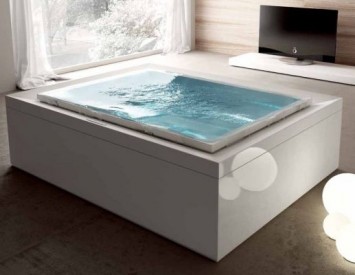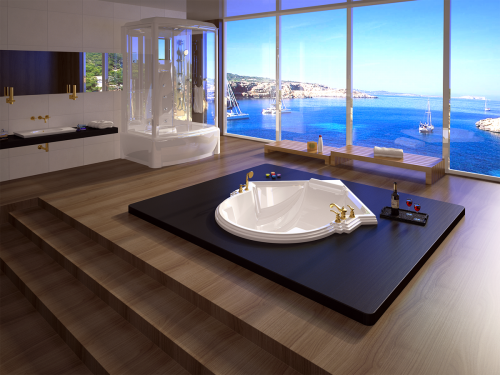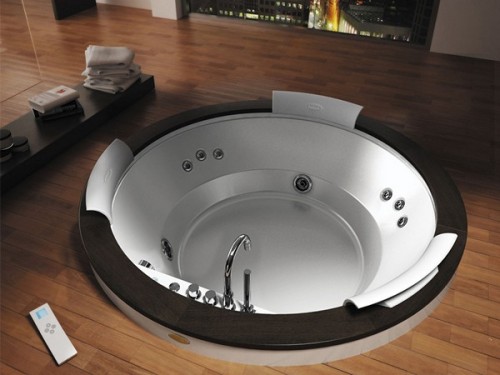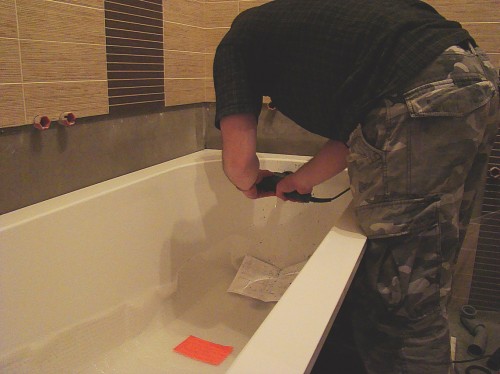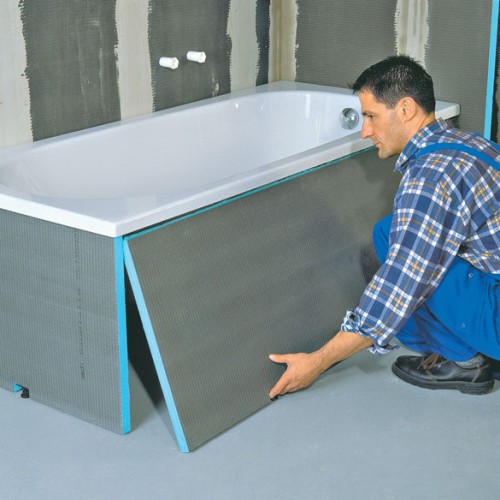The built -in bath, unlike the standard model, has constructive features that distinguish such a product from a dozen others. The whole charm of such a design solution is the visual savings of space. Integrated baths look exquisite and harmonious in any interior. The only thing is the installation of baths built into the floor is technically complicated.
Content
We will analyze the design features of the installation of plumbing of this type, we note the advantages and disadvantages, and understand the installation procedure.
Distinctive features
- The main difference between traditional baths and these plumbing products lies in the size and configuration of the bottom. Often built -in baths - impressive structures with a flat bottom. The developers emphasize the grandeur of the vessel. Indeed, in large rooms, standard baths will look like a trivial puddle.
- Another difference between the baths built into the floor or countertop is the presence of ramps from the side inner sides. This technological innovation allows you to extinguish water flows that strive to splash out on an expensive carpet or handmade parquet. Built -in baths are often used in country houses. Plumbing reinforcement is cut into the floor, decorated with parquet or laminate.
- The drain mechanism of such structures is also distinguished by the original performance. In most cases, manufacturers offer products complete with siphons, which in turn are produced in accordance with high safety requirements. This is an important aspect, mindful of installing such baths in the houses of noble gentlemen.
Varieties of built -in baths
Such products are not produced for a wide mass of consumers. Based on this, a limited choice of models and configurations is understandable. Built -in baths are conditionally divided into groups according to the criteria of dimensions and forms. If on the market you can find dishes of various sizes, then the variety of forms is not among the virtues of the solution. The shape of the bath can be:
- round;
- rectangular;
- corner.
The former enjoy the greatest love among designers-round plumbing products give the interior of the bathroom a luxurious style and make a mini-museum from the bathroom for excursions.
In addition, built -in baths differ in material for production. By analogy with similar models of the standard type, the market is represented in large quantities cast -iron built -in baths, acrylic, as well as steel ones. Of these, an unconditional favorite is acrylic. From this material you can make a bath of any shape and size.
Buy bath built into the floor: installation conditions
To install an oval or corner bath to the floor, certain conditions must be taken into account. Without them, installation is doomed to failure. We list the mandatory conditions:
- The inability to install in a city apartment. Even with the technical reality of the installation of the structure on the ground floor of an apartment building, not a single state competent organization will be given to you permission. The unauthorized installation will lead to a violation of not only the plan of the apartment, but also the integrity of the residential structure.
- The optimal installation condition is a private house with a spacious bathroom. We make a reservation, it is necessary to install on the ground floor or in the basement. Otherwise, it will be necessary to provide a reinforced concrete structure during construction to support the bath. It is not enough just to buy a built -in bath, you will have to work hard for installation.
- An important condition is the supply of a sewer system with a pre -installed pumping station. As you can see, such bathtubs are more like designed by jacuzzi, or pools. Calculate the costs not only on the purchase and installation of the structure, but also for a fair amount of water necessary for full set. On average, the volume of tanks reaches 300 liters.
- Finally, a prerequisite for installing baths of this kind is a professional team of plumbing installers. It is almost impossible to conduct installation independently due to the high complexity of some operations.
How to install built -in baths: important nuances
- For high -quality installation of the structure, a pit is needed. It is not enough just to dig a hole, you will have to concrete the floor and walls using a high -quality solution. In this case, the pit should be made exactly in the shape of a bath. In fact, if you place a plumbing product in a niche, it should sit down as cast.
- An important nuance: the larger the area of \u200b\u200bthe stops of the sides, the more reliable.
- The depth of the pit must be calculated in such a way that the bathtub mounted on the legs towers a maximum of 50 mm above the floor. In the future, the supports are fixed, and the bath is based on the final floor.
- Sewer and water communications stretch into the pit. The optimal place for this is the area of \u200b\u200bthe pit in the area of \u200b\u200bthe hidden hatch. You can see all the structural features of the built -in baths in the photo.
- Next is the assembly directly. As a rule, at this stage, experts establish a siphon and attach the support to the bottom of the support in accordance with the recommendations of the manufacturer. Probably, you will also need to cut the mixer into the board of the bath. The main thing is to follow the instructions and not replace the factory units of plumbing with other details.
- The next stage is installation and connection. It is necessary to insert the bath into the pit, lifting the legs to the maximum possible position. The rest is as in the usual connection diagram: connecting to the sewer network, then to the water supply. It is advisable to use corrugated metal sleeves made of stainless steel for connection. Flexible hoses are not reliable and not durable.
- Finally, a test test is performed - water is filled, the tightness of the joints and nodes is checked.
- The final stage is considered to be a floor cladding. For bathrooms recently, 3D field technology has been used. Such rooms are transformed, give new sensations. Traditional options include laminate, marble, parquet, tiles.
Bathroom furniture: how to assemble a countertop
The trend of our time is the roll towards uncomplicated decisions, original executions. In this regard, the bathroom is the best place for experiments. Furniture today does not surprise at all in miniature rooms with plumbing.
Bath furniture is developed for built -in plumbing elements like a sink or bath. Moreover, such countertops are made from improvised materials - MDF, drywall. It is curious, the installation of the skeleton for the countertop is carried out according to the same rules as for other rooms.
- At the desired height of the installation of a bath or sink, it is necessary to draw a line along which guide profiles will be attached.
- Using the guide in the form of a landmark, the contours of the structure should be formed.
- Then it is recommended to sheathe the frame, leaving the space for maneuvers.
- Form a cut under a washbasin or bath.
- Fix the sheets of drywall, not forgetting about the supports (this is necessary to support massive structures).
- The final stage is the installation of plumbing reinforcement, as in the case of the baths built into the floor, and surface finish. Mosaic or tiles are suitable as finishing material. This will give the structure a complete look and protect inhospitable drywall from water.
By the way, the bath, built under the countertop, is decorated in the same way. It is enough to determine the dimensions, draw markings for supporting profiles and collect a simple frame. Then it must be additionally strengthened and sheathed. This rule also works when using MDF as the basis of a countertop.
Built -in plumbing in any case will be a highlight of bathrooms, especially in combination with skillfully collected and decorated countertops and sex. Now you know how to install a built -in bath, how to assemble a countertop and decorate it. The case remains small!
